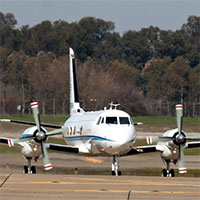Atmospher Sci & Global Chg
Research Highlights
November 2013
With Our Sites in the Sky
ARM's Aerial Facility provides extensive datasets, new upgrades extend capabilities

The ARM Climate Research Facility has provided the scientific community with extensive and freely available datasets since 2006. The facility includes a Gulfstream-I aircraft, shown here with the wing and nose pylons fully loaded with a total of eight cloud and aerosol probes. Enlarge Image.
Results: To bridge the gap between satellite-based data and that from our planet's surface, scientists obtain detailed measurements with the Atmospheric Radiation Measurement (ARM) Aerial Facility (AAF). In the Bulletin of the American Meteorological Society, the Facility Director Dr. Beat Schmid and his colleagues detailed the scientific endeavors achieved using data from the research facility. The facility, which includes a Gulfstream-1 (G-1) and contracted aircraft along with a suite of high-end instruments, produces freely available data for studying atmospheric particles and gases, clouds, the transfer of energy between the Earth and sky, and other atmospheric interactions.
Schmid's collaborators on this article are from his team at Pacific Northwest National Laboratory and scientists from Lawrence Berkeley National Laboratory, University of Colorado, and the University of Illinois.
Why It Matters: Droughts and floods can devastate populations and economies. Answering tough questions about these and other climate-based phenomena requires comprehensive data on atmospheric processes. The airborne observations acquired by the facility provide high-resolution in situ measurements that enhance surface-based measurements. Specifically, the facility's measurements promote understanding atmospheric processes, developing instruction sets for the models to work with the processes, and evaluating models- all of which are not possible using surface- or satellite-based techniques. Further, the facility works on maturing and testing of newly developed airborne sensors for next-generation instruments.
Methods: The researchers reviewed the scientific literature that has used data from the nine facility campaigns that have occurred since 2006. These campaigns have resulted in more than 70 peer-reviewed journal articles. They also described the current research capabilities of the facility. They emphasize recent developments made possible by the American Recovery and Reinvestment Act of 2009, including the procurement of more than 20 new instruments used aboard the G-1 and contracted aircraft.
"The ARM Aerial Facility has matured, and now provides an extensive in-house capability," said Schmid.
What's Next? The AAF just concluded a 4-month-long campaign to study aerosol particles and gases emitted from wild fires in the Pacific Northwest and agricultural burns near Memphis, Tennessee, as part of the Biomass Burn Observation Project. The next two research campaigns will be in 2014 in Brazil. Scientists will study the emission and transport of aerosol and gases from the megacity Manaus into the pristine and largely uninhabited Amazon environment.
The ARM website has more information on past and future ARM Climate Research Facility campaigns, including AAF.
Acknowledgments
Sponsors: The ARM Climate Research Facility is funded through the U.S. Department of Energy (DOE) Office of Science and is managed through the Office of Biological and Environmental Research.
Research Area: Climate & Earth Systems Science
Research Team: Beat Schmid, Jason Tomlinson, John Hubbe, Jennifer Comstock, Fan Mei, Duli Chand, and Mikhail Pekour, Pacific Northwest National Laboratory (PNNL); CD Kluzek, formerly with PNNL and now at Mojave, California; E Andrews, University of Colorado, Boulder; SC Biraud, Lawrence Berkeley National Laboratory, and GM McFarquhar, University of Illinois, Urbana-Champaign
Reference: Schmid B, JM Tomlinson, JM Hubbe, JM Comstock, F Mei, D Chand, MS Pekour, CD Kluzek, E Andrews, SC Biraud, and GM McFarquhar. 2013. "The DOE ARM Aerial Facility." Bulletin of the American Meteorological Society 95(5). In advance of print. DOI: 10.1175/BAMS-D-13-00040.1
